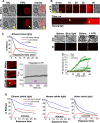Blue light excited retinal intercepts cellular signaling
- PMID: 29976989
- PMCID: PMC6033873
- DOI: 10.1038/s41598-018-28254-8
Blue light excited retinal intercepts cellular signaling
Abstract
Photoreceptor chromophore, 11-cis retinal (11CR) and the photoproduct, all-trans retinal (ATR), are present in the retina at higher concentrations and interact with the visual cells. Non-visual cells in the body are also exposed to retinal that enters the circulation. Although the cornea and the lens of the eye are transparent to the blue light region where retinal can absorb and undergo excitation, the reported phototoxicity in the eye has been assigned to lipophilic non-degradable materials known as lipofuscins, which also includes retinal condensation products. The possibility of blue light excited retinal interacting with cells; intercepting signaling in the presence or absence of light has not been explored. Using live cell imaging and optogenetic signaling control, we uncovered that blue light-excited ATR and 11CR irreversibly change/distort plasma membrane (PM) bound phospholipid; phosphatidylinositol 4,5 bisphosphate (PIP2) and disrupt its function. This distortion in PIP2 was independent of visual or non-visual G-protein coupled receptor activation. The change in PIP2 was followed by an increase in the cytosolic calcium, excessive cell shape change, and cell death. Blue light alone or retinal alone did not perturb PIP2 or elicit cytosolic calcium increase. Our data also suggest that photoexcited retinal-induced PIP2 distortion and subsequent oxidative damage incur in the core of the PM. These findings suggest that retinal exerts light sensitivity to both photoreceptor and non-photoreceptor cells, and intercepts crucial signaling events, altering the cellular fate.
Conflict of interest statement
The authors declare no competing interests.
Figures








Similar articles
-
Blue light-triggered photochemistry and cytotoxicity of retinal.Cell Signal. 2020 May;69:109547. doi: 10.1016/j.cellsig.2020.109547. Epub 2020 Jan 23. Cell Signal. 2020. PMID: 31982549 Free PMC article.
-
The 11-cis Retinal Origins of Lipofuscin in the Retina.Prog Mol Biol Transl Sci. 2015;134:e1-12. doi: 10.1016/bs.pmbts.2015.07.022. Prog Mol Biol Transl Sci. 2015. PMID: 26310175 Review.
-
Light-induced damage to the retina: role of rhodopsin chromophore revisited.Photochem Photobiol. 2005 Nov-Dec;81(6):1305-30. doi: 10.1562/2004-11-13-IR-371. Photochem Photobiol. 2005. PMID: 16120006 Review.
-
Age-related maculopathy and the impact of blue light hazard.Acta Ophthalmol Scand. 2006 Feb;84(1):4-15. doi: 10.1111/j.1600-0420.2005.00627.x. Acta Ophthalmol Scand. 2006. PMID: 16445433 Review.
-
The Visual Cycle in the Inner Retina of Chicken and the Involvement of Retinal G-Protein-Coupled Receptor (RGR).Mol Neurobiol. 2017 May;54(4):2507-2517. doi: 10.1007/s12035-016-9830-5. Epub 2016 Mar 17. Mol Neurobiol. 2017. PMID: 26984602
Cited by
-
Optical approaches for single-cell and subcellular analysis of GPCR-G protein signaling.Anal Bioanal Chem. 2019 Jul;411(19):4481-4508. doi: 10.1007/s00216-019-01774-6. Epub 2019 Mar 30. Anal Bioanal Chem. 2019. PMID: 30927013 Free PMC article. Review.
-
Recombinant-Chemosynthetic Biosensors for Probing Cell Surface Signaling of Red Blood Cells and Other Cells.Chem Biomed Imaging. 2025 Jan 3;3(2):95-110. doi: 10.1021/cbmi.4c00067. eCollection 2025 Feb 24. Chem Biomed Imaging. 2025. PMID: 40018647 Free PMC article.
-
Causal Pluralism in Medicine and its Implications for Clinical Practice.J Gen Philos Sci. 2024;55(3):377-398. doi: 10.1007/s10838-023-09658-1. Epub 2023 Nov 3. J Gen Philos Sci. 2024. PMID: 39554999 Free PMC article.
-
Effects of light on aging and longevity.Ageing Res Rev. 2019 Aug;53:100913. doi: 10.1016/j.arr.2019.100913. Epub 2019 May 30. Ageing Res Rev. 2019. PMID: 31154014 Free PMC article. Review.
-
Blue light-triggered photochemistry and cytotoxicity of retinal.Cell Signal. 2020 May;69:109547. doi: 10.1016/j.cellsig.2020.109547. Epub 2020 Jan 23. Cell Signal. 2020. PMID: 31982549 Free PMC article.
References
Publication types
MeSH terms
Substances
LinkOut - more resources
Full Text Sources
Other Literature Sources
Miscellaneous

